
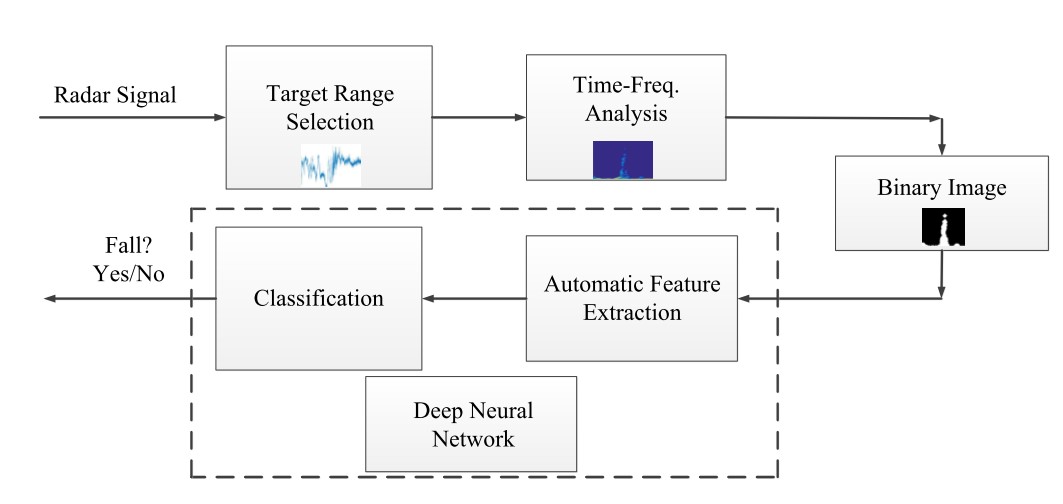
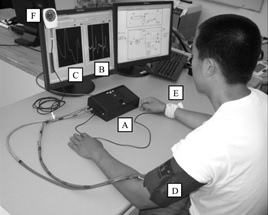
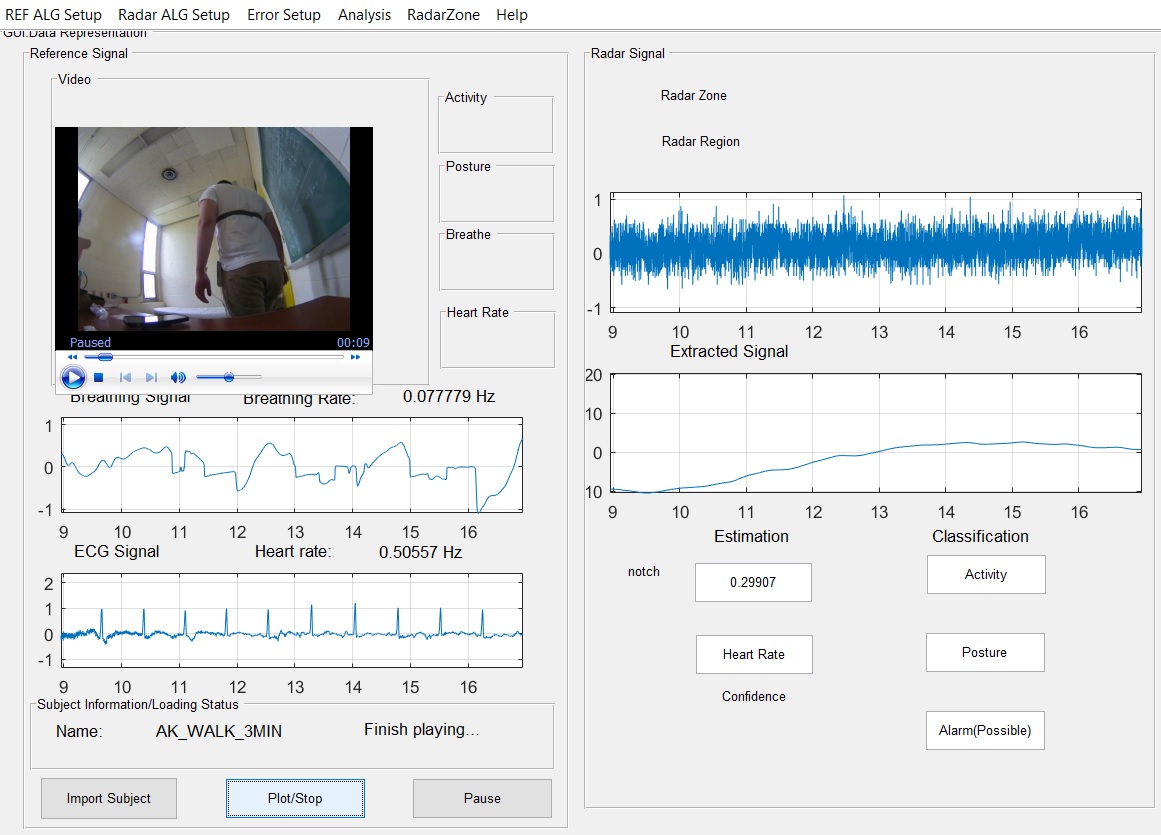
Recently Completed Projects
The order of the projects is based on the time of publication of the most recent paper.
Fall detection based on radars using deep learning
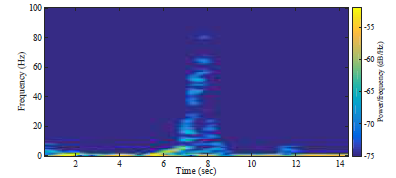
Automatic fall detection using radar has many applications in smart home care and elderly’s houses. In this project, several new methods for detecting fall incidents in human daily activities based on deep neural network were proposed. Unlike other existing works on radar-based fall detection that mostly rely on heuristic feature extraction using time-frequency analysis of the radar return signals, the proposed methods were realized by hierarchical feature learning directly from the radar return time series.
Published Papers and Reports
- H. Sadreazami, M. Bolic and S. Rajan, "CapsFall: Fall Detection Using Ultra-Wideband Radar and Capsule Networks," IEEE Access, vol. 7, pp 55336-55343, 2019.
- H. Sadreazami, S. Rajan and M. Bolic, "Fall Detection using Standoff Radar-based Sensing and Deep Convolutional Neural Network," IEEE Transactions on Circuits and Systems II: Express Briefs, March, 2019.
- H. Sadreazami, S. Rajan and M. Bolic, “Residual Network-Based Supervised Learning of Remotely Sensed Fall Incidents Using Ultra-Wideband Radar,” 2019 IEEE International Symposium on Circuits and Systems (ISCAS), pp. 1-4, 2019.
- H. Sadreazami, S. Rajan and M. Bolic, “On the use of ultra wideband radar and stacked LSTM-RNN for at home fall detection,” in Proc. Life Sciences Conference (LSC), 2018.
Life sign monitoring system

The outcome of this project will be the proof of concept system that will demonstrate technical feasibility of breathing rate estimation of one and two people using radars. We will also evaluate heart rate estimation with UWB radar and with FMCW radars. The project duration is 6 months.
Members
Shan He, Ph.D. student
Rajitha Hathurusinghe, M.Sc. student
Dr. Varunkumar Mehta, Post-doctoral Fellow
Dr. Miodrag Bolic
Industrial sponsor or collaborator
Aerosystems International Inc., Montreal
Status
Phase 2 of the project.
Blood pressure estimation
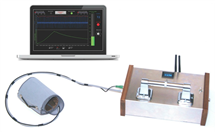
Available blood pressure home monitoring systems provide only the systolic and diastolic blood pressure. They do not permit the concurrent measurement and detailed analysis of the pulse and the ECG waveforms, which are important biomarkers of health and illness. We developed a multi-sensor multi-parameter blood pressure monitor that is robust in the face of measurement uncertainty and noise. The developed monitor was based on mathematical model of the overall system including artery, tissue and cuff. The monitor differed from existing systems in its emphasis on sensor fusion, establishing confidence in the measurement and providing a range of information to practitioners.
Published Papers and Reports
- H. N. Abderahman, H. R. Dajani, M. Bolic, V. Z. Groza, “An Integrated Blood Pressure Measurement System for Suppression of Motion Artifacts,” Computer Methods and Programs in Biomedicine, Elsevier, Vol. 145, pp. 1-10, 2017.
- S. Baktash, M. Forouzanfar, I. Batkin, M. Bolic, V. Z. Groza, S. Ahmad, H. R. Dajani, “Characteristic Ratio-Independent Arterial Stiffness-Based Blood Pressure Estimation,” IEEE Journal of Biomedical and Health Informatics (J-BHI), Vol. PP, Issue: 99, 2016.
- M. Forouzanfar, S. Rajan, I. Batkin, H. R. Dajani, M. Bolic, and V. Groza, “Oscillometric Blood Pressure Estimation: Past, Present, and Future,” accepted for publication in Reviews in Biomedical Engineering, 2015.
- M. Forouzanfar, S. Ahmad, I. Batkin, H. R. Dajani, M. Bolic, and V. Groza, “Model-Based Mean Arterial Pressure Estimation Using Simultaneous Electrocardiogram and Oscillometric Blood Pressure Measurements,” IEEE Transactions on Instrumentation and Measurements, Issue 99, 2015.
- M. Forouzanfar, I. Batkin, H. R. Dajani, M. Bolic, V. Groza, S. Rajan, “Ratio-Independent Blood Pressure Estimation by Modeling the Oscillometric Waveform Envelope,” IEEE Transactions on Instrumentation and Measurements, short paper, Vol. 63, Issue 10, pp. 2501-2503, 2014.
- I.Batkin, S. Ahmad, M. Bolic, V. Groza, H. Dajani, M. Forouzanfar, “Apparatus and Method for ECG Assisted Blood Pressure Measurement,” Canada patent, Application number: 2,276,204, 2014.
- M. Forouzanfar, S. Ahmad, I. Batkin, H. R. Dajani, M. Bolic, and V. Groza, “Coefficient-Free Blood Pressure Estimation Based on Pulse Transit Time-Cuff Pressure Dependence,” IEEE Transactions on Biomedical Engineering, Vol. 60, Issue 7, 1814 – 1824, 2013.
- S. Ahmad, I. Batkin, O. Kelly, H. R. Dajani, M. Bolic, and V. Groza, “Multi-Parameter Physiological Analysis in Obstructive Sleep Apnea Simulated With Mueller Maneuver,” IEEE Transactions of Instrumentation and Measurements, Vol. 62, Issue 10, pp. 2751 – 2762, 2013.
- K. Soueidan, S. Chen, H. R. Dajani, M. Bolic and V. Groza, “Augmented blood pressure measurement through the noninvasive estimation of physiological arterial pressure variability,” Physiological Measurement, Vol 33, Issue 6, pp. 881-899, 2012.
- S. Ahmad, S. Chen, K. Soueidan, I. Batkin, M. Bolic, H. Dajani, V. Groza, “Electrocardiogram-Assisted Blood Pressure Estimation,” IEEE Transactions on Biomedical Engineering, Vol. 59, No. 3, pp. 608-618, 2012.
- M. Forouzanfar, H. R. Dajani, V. Z. Groza, M. Bolic, S. Rajan, “Feature-based Neural Network Approach for Oscillometric Blood Pressure Estimation,” IEEE Transactions on Instrumentation and Measurements, vol 60, no. 8, pp. 2786 - 2796, 2011.
- S. Chen, M. Bolic, V. Z. Groza, H. R. Dajani, I. Batkin, S. Rajan, “Extraction of Breathing Signal and Suppression of its Effects in Oscillometric Blood Pressure Measurement,” IEEE Transactions on Instrumentation and Measurements, vol 60, no. 5, pp. 1741 - 1750, 2011.
- S. Ahmad, M. Bolic, H. Dajani, V. Groza, I. Batkin, “Measurement of Heart Rate Variability Using an Oscillometric Blood Pressure Monitor,” IEEE Transactions on Instrumentation and Measurements, vol. 59, no. 10, pp. 2575-2590, 2010.
Non-invasive brain stimulation
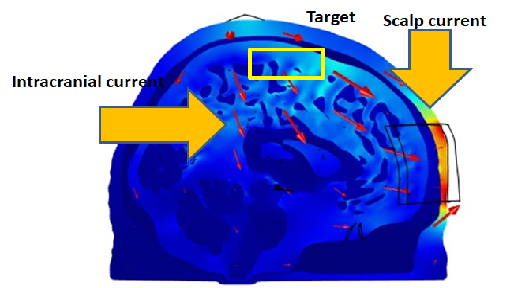
Transcranial direct current stimulation (tDCS) is a non-invasive brain stimulation technique in which a continuous current is delivered to the brain. Our research on stimulation was related to improving tDCS and personalizing the stimulation based on the feedback information using bioimpedance measurements on the head. We found multiple ways to improve the efficacy of non-invasive brain stimulation with the goal of reducing the number of non-responders.
Published Papers and Reports
- S. Gholami-Boroujeny, M. Bolic, “Extraction of Cole parameters from the electrical bioimpedance spectrum using bacterial foraging optimization algorithm,” conditionally accepted in Medical & Biological Engineering & Computing, Springer, 2015.
- I. Nejadgholi, M. Bolic, “A Comparative Study of PCA, SIMCA and Cole model for Classification of Bioimpedance Spectroscopy Measurements,” Computers in Biology and Medicine, Elsevier, Vol. 63, pp 42 – 51, 2015.
- I. Nejadgholi, H. Caytak, M. Bolic, I. Batkin, S. Shirmohammadi, “Preprocessing and Parameterizing of Bioimpedance Spectroscopy Measurements By Singular Value Decomposition,” Physiological Measurement, Vol. 36, No. 5, pp. 983-999, May 2015.
- H. Caytak, D. Shapiro, A. Borisenko and M. Bolic, “Advances in tDCS could provide a mainstream clinical tool for noninvasive neuromodulation,” IEEE Pulse, Vol 6, Issue 2, pp. 21-24, 2015.
- F. Tremblay, A. Remaud, A. Mekonnen, S. Gholami-Boroujeny, K. Racine, M. Bolic, “Lasting Depression in Corticomotor Excitability associated with Local Scalp Cooling,” conditionally accepted in Neuroscience Letters, Elsevier, 2015.
- S. Gholami-Boroujeny, A. Mekonnen, I. Batkin, M. Bolic, “Theoretical Analysis of the Effect of Temperature on Current Delivery to the Brain during tDCS,” Brain Stimulation, Elsevier, http://dx.doi.org/10.1016/j.brs.2014.12.006, 2015.
- O. Dragichi, I. Batkin, I.S. Chapman, M. Bolic, et al, “Neurostimulation System, Device, and Method,” US 8,874,220 B2, 2014.
- O. Draghici, I. Batkin, I. Chapman, M. Bolic, “Performance Evaluation of the MouthPad,” MeMea 2014.
- O. Draghici, I. Batkin, I. Chapman, M. Bolic, “The MouthPad: a Tongue-Computer Interface,” MeMeA 2013.
- H. Caytak, I. Batkin, A. Mekonnen, D. Shapiro, S. Hassoun, G. Li, H. R Dajani, M. Bolic, “Superabsorbent Polymer Electrode for Transcranial Direct Current Stimulation,” MeMeA 2013.

